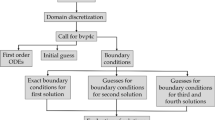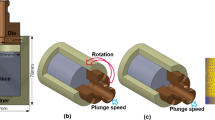Abstract
In robotic friction stir welding, high rotational speed is constantly employed to reduce both robot torque and the welding load. In this paper, a three-dimensional coupled thermo-mechanical model is developed. This model analyzes the multiphysics field in both friction stir welding and stationary shoulder friction stir welding at relatively high rotational speeds. Both experimental and numerical results indicate that the stationary shoulder friction stir welding joint has homogenous microstructure and temperature gradient distribution. Further research finds the peak temperature in the nugget zone of stationary shoulder friction stir welding and friction stir welding is 490° and 530°, respectively. Meanwhile, the effective strain of the stationary shoulder friction stir welding joint is lower when compared to the friction stir welding. However, the strain rate is higher. While being reduced along the thickness direction, the strongest material flow velocity is observed in the top surface of the workpiece. Stationary shoulder friction stir welding is shown as a favorable process for obtaining the homogeneity of the microstructure and reducing joint softening.













Similar content being viewed by others
References
M. Xu, B. Liu, Y. Zhao et al., Direct Joining of Thermoplastic ABS to Aluminum Alloy 6061-T6 Using Friction Lap Welding, Sci. Technol. Weld. Join., 2020 https://doi.org/10.1080/13621718.2020.1719304
Y. Chen, H. Liu and J. Feng, Friction Stir Welding Characteristics of Different Heat-Treated-State 2219 Aluminum Alloy Plates, Mater. Sci. Eng. A., 2006, 420(1–2), p 21–25.
V. Pandian and S. Kannan, Numerical Prediction and Experimental Investigation of Aerospace-Grade Dissimilar Aluminum Alloy by Friction Stir Welding, J. Manuf. Process., 2020, 54, p 99–108.
P.L. Threadgill, A.J. Leonard, H.R. Shercliff et al., Friction Stir Welding of Aluminum Alloys, Int. Mater. Rev., 2009, 54(2), p 49–93.
J. You, Y. Zhao, C. Dong et al., Microstructure Characteristics and Mechanical Properties of Stationary Shoulder Friction Stir Welded 2219-T6 Aluminum Alloy at High Rotation Speeds, Int. J. Adv. Manuf. Technol., 2019 https://doi.org/10.1007/s00170-019-04594-1
J.Q. Li and H.J. Liu, Effects of Tool Rotation Speed on Microstructures and Mechanical Properties of AA2219-T6 Welded by the External Non-rotational Shoulder Assisted Friction Stir Welding, Mater. Des., 2013, 43, p 299–306.
T. Sun, M.J. Roy, D. Strong et al., Comparison of Residual Stress Distributions in Conventional and Stationary Shoulder High-Strength Aluminum Alloy Friction Stir Welds, J. Mater. Process. Technol., 2017, 242, p 92–100.
H. Wu, Y.C. Chen, D. Strong et al., Stationary Shoulder FSW for Joining High Strength Aluminum Alloys, J. Mater. Process. Technol., 2015, 221, p 187–196.
S. Sinhmar and D.K. Dwivedi, Mechanical Behavior of FSW Joint Welded by a Novel Designed Stationary Shoulder Tool, J. Mater. Process. Technol., 2020, 277, p 116482.
H. Su, C.S. Wu, M. Bachmann et al., Numerical Modeling for the Effect of Pin Profiles on Thermal and Material Flow Characteristics in Friction Stir Welding, Mater. Des., 2015, 77, p 114–125.
L. Fratini, G. Buffa, D. Palmeri et al., Material Flow in FSW of AA7075-T6 Butt Joints: Numerical Simulations and Experimental Verifications, Sci. Technol. Weld. Join., 2006, 11(4), p 412–421.
B. Vicharapu, H. Liu, H. Fujii et al., Probing Residual Stresses in Stationary Shoulder Friction Stir Welding Process, Int. J. Adv. Manuf. Technol, 2020, 106(5), p 1573–1586.
Q. Wen, W.Y. Li, W.B. Wang et al., Experimental and Numerical Investigations of Bonding Interface Behavior in Stationary Shoulder Friction Stir Lap Welding, J. Mater. Sci. Technol., 2019, 35(1), p 192–200.
Y. Zhao, H. Liu, T. Yang et al., Study of Temperature and Material Flow During Friction Spot Welding of 7B04-T74 Aluminum Alloy, Int. J. Adv. Manuf. Technol., 2016, 83(9–12), p 1467–1475.
H. Pashazadeh, A. Masoumi and J. Teimournezhad, Numerical Modelling for the Hardness Evaluation of Friction Stir Welded Copper Metals, Mater. Des., 2013, 49, p 913–921.
L. Fratini, G. Buffa and R. Shivpuri, Mechanical and Metallurgical Effects of in Process Cooling During Friction Stir Welding of AA7075-T6 Butt Joints, Acta Mater., 2010, 58(6), p 2056–2067.
H. He, Y. Yi, J. Cui et al., Hot Deformation Characteristics and Processing Parameter Optimization of 2219 Al Alloy Using Constitutive Equation and Processing Map, Vacuum, 2019, 160, p 293–302.
H. Schmidt and J. Hattel, A Local Model for the Thermomechanical Conditions in Friction Stir Welding, Model. Simul. Mater. Sci. Eng., 2004, 13(1), p 77.
Q. Wen, W.Y. Li, Y.J. Gao et al., Numerical Simulation and Experimental Investigation of Band Patterns in Bobbin Tool Friction Stir Welding of Aluminum Alloy, Int. J. Adv. Manuf. Technol., 2019, 100(9–12), p 2679–2687.
R. Hamilton, D. MacKenzie and H. Li, Multi-Physics Simulation of Friction Stir Welding Process, Eng. Comput., 2010 https://doi.org/10.1108/02644401011082980
R. Fonda, A. Reynolds, C.R. Feng et al., Material Flow in Friction Stir Welds, Metall. Mater. Trans. A., 2013, 44(1), p 337–344.
G.R. Cui, Z.Y. Ma and S.X. Li, Periodical Plastic Flow Pattern in Friction Stir Processed Al-Mg Alloy, Scr. Mater., 2008, 58(12), p 1082–1085.
L. Liu, Y. Wu, H. Gong et al., A Physically Based Constitutive Model and Continuous Dynamic Recrystallization Behavior Analysis of 2219 Aluminum Alloy During Hot Deformation Process, Materials., 2018, 11(8), p 1443.
G. Chen, Z. Feng, Y. Zhu et al., An Alternative Frictional Boundary Condition for Computational Fluid Dynamics Simulation of Friction Stir Welding, J. Mater. Eng. Perform., 2016, 25(9), p 4016–4023.
R. Kumar, V. Pancholi and R.P. Bharti, Material Flow Visualization and Determination of Strain Rate During Friction Stir Welding, J. Mater. Process. Technol., 2018, 255, p 470–476.
H. Liu and H. Fujii, Microstructural and Mechanical Properties of a Beta-Type Titanium Alloy Joint Fabricated by Friction Stir Welding, Mater. Sci. Eng. A., 2018, 711, p 140–148.
P.B. Prangnell and C.P. Heason, Grain Structure Formation During Friction Stir Welding Observed by the ‘Stop Action Technique,’ Acta Mater., 2005, 53(11), p 3179–3192.
N. Dudova, A. Belyakov, T. Sakai et al., Dynamic Recrystallization Mechanisms Operating in a Ni-20% Cr Alloy Under Hot-to-Warm Working, Acta Mater., 2010, 58(10), p 3624–3632.
O.R. Myhr, Ø. Grong and S.J. Andersen, Modelling of the Age Hardening Behaviour of Al-Mg-Si Alloys, Acta Mater., 2001, 49(1), p 65–75.
C. Genevois, A. Deschamps, A. Denquin et al., Quantitative Investigation of Precipitation and Mechanical Behaviour for AA2024 Friction Stir Welds, Acta Mater., 2005, 53(8), p 2447–2458.
J.Q. Li and H.J. Liu, Characteristics of the Reverse Dual-Rotation Friction Stir Welding Conducted on 2219-T6 Aluminum Alloy, Mater. Des., 2013, 45, p 148–154.
Acknowledgments
Financial support for this work was supported by the Key areas Research and Development Program of Guangdong Province (2019B090921003), the National Natural Science Foundation of China (51905112), by the Science and Technology Plan Project of Guangzhou City (201807010063), and by the International Science and Technology Cooperation Project of Guangzhou Economic and Technological Development Zone (2019GH15). The authors are grateful to Wuxi Turbine Blade Co., Ltd for providing software ‘DEFORM’ support and engineer Ji Liu supports.
Author information
Authors and Affiliations
Corresponding authors
Additional information
Publisher's Note
Springer Nature remains neutral with regard to jurisdictional claims in published maps and institutional affiliations.
Rights and permissions
About this article
Cite this article
You, J., Zhao, Y., Dong, C. et al. Numerical Modeling of Multiphysics Field in Conventional and Stationary Shoulder Friction Stir Welding of Al-Cu Alloy. J. of Materi Eng and Perform 30, 2751–2760 (2021). https://doi.org/10.1007/s11665-021-05642-2
Received:
Revised:
Accepted:
Published:
Issue Date:
DOI: https://doi.org/10.1007/s11665-021-05642-2




